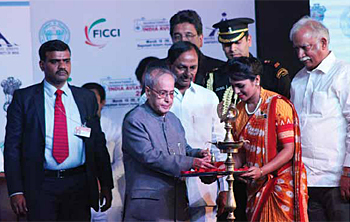- Prime Minister Narendra Modi inaugurates Aero India 2023 in Bengaluru; Releases Commemorative Stamp
- Defence Secretary meets delegations from Saudi Arabia, USA and Oman on the sidelines of Aero India 2023
- Foreign Ministers of 32 countries to attend Aero India 2023
- Embraer showcases the C-390 Millennium at Aero India 2023
Flying Start to India Aviation
- Government to invest over $120 billion in aviation infrastructure
- India to become third largest aviation market soon

2016 by lighting the Ceremonial Lamp
The government is planning to invest over $120 billion for development of airport infrastructure and aviation navigation services over the next decade to propel the growth of the civil aviation sector in the country, the President Pranab Mukherjee said. This is the first time that India Aviation, in its fifth edition, was inaugurated by the President of India.
While expressing happiness over the rapid growth of the civil aviation market with India set to emerge as the third largest aviation market in the world by 2020, the President said much remains to be done in terms of improving penetration and regional connectivity.
“The deeper air penetration to smaller cities; better connectivity to North Eastern part of India; higher disposable incomes of the middle class of India is expected to further propel the growth of the country’s civil aviation industry,” he said.
With a network of domestic and 85 international airlines connecting 40 countries, Indian airports handled passenger traffic of 190 million persons in 2015. Yet, India is one of the least penetrated air-markets in the world with 0.04 trips per capita per annum as compared to 0.3 of China and more than two in the USA, the President pointed out.
Despite rapid growth of aviation industry, several Tier-II and Tier-III cities of India still remain unconnected or inadequately connected with the national grid. Stating that the middle-income population of India has grown by 60 per cent over the last five years and has reached about 270 million in 2016, the President said: “The consistent increase in income levels of the middle class in India has enhanced their capacity to undertake air travel for business and leisure. This has resulted in further growth in the business of low-cost airlines.”
421 million passengers by 2020
By 2020, the total passenger traffic in India is likely to touch 421 million. “It is time for the government and all stakeholders of the civil aviation industry to leverage this tremendous business opportunity,” he said. It is estimated that India should require at least 800 aircraft by 2020 to cater to the phenomenal increase of air passenger and freight traffic. The supporting aviation infrastructure has to be suitably upgraded by building new greenfield airports; expanding the existing airports and upgrading facilities for maintenance, repair and operations. While India has registered 14 per cent growth in the sector during the last decade, the foreign direct investment (FDI) in air transport during last 15 years has touched the mark of $570 million. “India continues to be a favourite destination for foreign investors in civil aviation sector,” Mukherjee noted.
The Minister of Civil Aviation, Ashok Gajapathi Raju said civil aviation has had a chequered past, sometimes flying, sometimes in turbulence. However, in the last one and a half years, it has been growing and the government was creating an eco-system for aviation growth. The government, along with state governments, were providing actionable inputs for the industry to benefit.
Telangana aerospace parks
The Chief Minister of Telangana, K. Chandrashekar Rao said Telangana had two aerospace parks and another one is in the offing. There were about 250 aerospace and defence companies in the state and Telangana is becoming a favoured investment destination for aerospace and other sectors.
The Civil Aviation Secretary, R.N. Chaubey said the growth of 20 per cent in passenger traffic in India is unparalled in the world. In the civil aviation landscape, India has arrived.
The President of FICCI (Federation of Indian Chambers of Commerce and Industry), Harshavardhan Neotia, proposed a vote of thanks.





